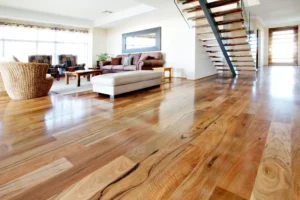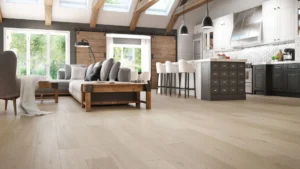You walk over your living room, and the flow under your feet feels so solid, warm, and full of character. You love it, but you have one question is crossing your mind. Maybe you think of rebuilding it, or perhaps a scratch makes you wonder, how can I fix it? The exquisite question is, what type of hardwood floor do I have? It looks likes an unsolver mystery. Is it oak, or is it maple? Is it a solid wood or something else? You do not have to be a flooring pro to know how to answer this. Consider it as your assisting tool. Let us solve this mystery together in some easy steps to help trace your floor with confidence.
The first big answer is solid or engineered hardwood?
This is the first big question to ask because your answer will affect everything regarding how you handle and renovate your floor. The difference is mostly straightforward.
Solid hardwood
it is exactly what it is called. Every plank is a single layer of wood, milled from a full piece of timber. It is a traditional eternal trend in flooring, robust enough to be sanded down and refurbished several times throughout its lifetime.
Engineered hardwood
it is a polished, innovative product. The plank’s top layer the “veneer- is made of real wood, which is complied glued-up to several plywood layers or high-density fiberboard underneath it. It is longer lasting and more durable, producing when the humidity changes, the veneer can only be renovated a limited number of times, dependent on its thickness.
The “no-nonsense” experiment: look at a board sideways.
What do you think looks different if you check at a cross-section of a board? How can you without having to hack apart your flow?
- Find a n edge: Look for a floor vent, a peek under a baseboard it may be a closet where you can see the side profile of a plank.
- What to look for:
- If you see one single, solid piece of wood all the way through, you have solid hardwood.
- If you see distinct layers, like a thin sheet of wood on top of what looks like plywood, you have engineered hardwood.
This one test will solve half the puzzle right away.

Becoming a wood detective: identifying the species.
Now that you know the construction, let’s play detective and figure out what kind of tree your floor came from. The clues are in the coo, the grain pattern, the hardness. Here are the most popular suspects you know you’ll find in homes throughout the USA until today.
Oak Flooring. The king of hardwood.
Oak is by far the most popular hardwood flooring in America. If you have an older home, the chance is you have oak. There are two main varieties:
- Red oak: has a warm, reddish–pink tone. The most prominent characteristic is a strong, wavy grain pattern very open. When you look at it, you see a lot of long lines and swirls in another word it’s sparkling.
- White oak: A more golden, brownish tone. Its grain is less open. It is also different “ray flecks” – the thin ribbon-like patterns across the grain that look like little tiger stripes or flames
maple flooring. The clean & modern choice.
Maple is loved because of its light cream color and a very smooth, close appearance.
- How do I spot it: Its grain pattern is very fine and understated. It’s much less busy than oak. Sometimes you will find distinctive patterns like “bird’s eye” dark circles or “curly maple” a wavy, three-dimensional shimmer. It’s generally a harder and more durable wood than oak.
Hickory Flooring. The tough & rustic character.
If your floor has a lot of personality and drama, it might be hickory. It’s one of the hardest domestic woods, making it incredibly durable.
- How do I spot it: Its most significant quality is the dramatic color variation. Boards that are almost white will be right next to boards that are deep, dark brown, all within the same plank. The grain is also very pronounced, and it’s often very dramatic and in focus.
Pro tip: the “water drop” test
This is a simple test to get a feel for your floor’s hardness. Be sure to test in an out-of-the-way spot, like inside a closet. Place a single drop of water on the surface.
- If the water soaks in quickly, the wood is more porous and a softer species like Red Oak.
- If the water beads up and stays on the surface for a while, the wood is very dense and hard, like maple or hickory. This would also tell you about the wood’s finish type but is a good clue for species identification.
The Finishing Touches: what’s on top?
The final piece of the puzzle is the finish. This is the protective layer that sits on top of the wood. Knowing this helps you choose the right cleaners.
Unfinished
It meant the raw wood planks had been installed, sanded and stained, and finished on-site. In many cases, you can tell because the finish flows right up to the baseboards with no little gap there. There are also bevels. The predone manufacturers said by this name who have a sharp enough eye that the entire surface on every side has a tiny beveled edge. This helps hide slight imperfections left during installation. A small hill, typically at a 45-degree angle, on each side of the plank facilitates precise stitching or gluing. These enhancements are called bevels and are small angled edges around the top of micro-bevels.
Prefinished
It is meant the planks were manufactured in a factory and finished before they ever arrived. The largest giveaway: micro-bevel. Almost all the planks have an incredibly small, beveled edge on all four sides. The micro bevels vary in size, but they’re usually no more prominent than a couple of millimeters. So small that if you seem at them dead on you may not actually see them at all.retenol Soak oil.
Common finish types
- Oil-based polyurethane: It gives a warm, amber, or slightly yellowish tone. verses Plastic-like look and feel.
- Water-based polyurethane. Your wood will remain free of charge and be so dry. It isn’t stained…. Precut island. Sinks soak in the wood fibers rather than in order thfitti So stiff, rusty, and matte.

Why does it Even Matter:
Knowing what you’re standing in gives you the power to care for it properly.
Clean
Cleaning oil-based material must differ from those made of water.
Repair
You can make your material new: find a putty or marker that fits your wood species and color.
Refinish
Is hardwood entangled? You can only refinish it a couple of times. You can renew more than once solid hardwood school furnishings.. simply before that, you need to know the thickness of that tip to know if it can be patched even once.
Frequently asked questions
Can I just send a picture to someone for identification?
You can, but it can be hard to tell from a photo alone. By using this guide, you can give them much better information the wood ” it’s a solid wood with a tight grain that has ray flecks, in this example, which will lead to a much more accurate answer.
What if my floor is painted?
Paint makes it tricky! Your best bet is to find a hidden area. Look inside a floor vent, under an appliance that never moves, or in a corner of a closet where the paint might have worn off.
Does it matter if my floor is really old?
Not at all! In fact, if you have an old home, you might have floors made from old-growth wood that is much harder and more stable than what is available today. The identification process is exactly the same.
You’re now the expert
Figuring out your floor doesn’t have to be a mystery. By looking at the side, checking the grain, and feeling the finish, you now have all the tools you need to solve the case. This knowledge will help you clean, repair, and refinish your beautiful floors, letting them last a lifetime.
